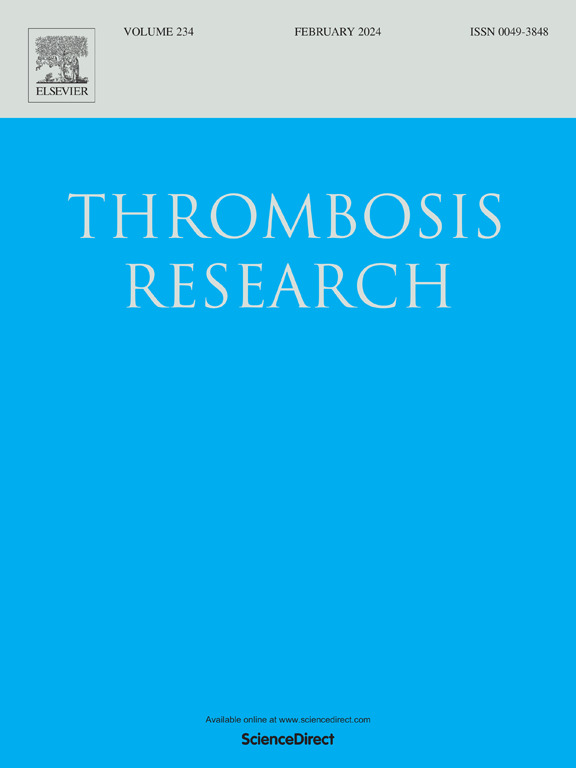tPA-ROTEM identifies hyperfibrinolytic profile in a significant proportion of patients with bleeding disorder of unknown cause (BDUC)
IF 3.7
3区 医学
Q1 HEMATOLOGY
引用次数: 0
Abstract
Background
In the majority of patients referred for evaluation of bleeding symptoms, no diagnosis can be made after extensive laboratory testing. These patients are classified as having a bleeding disorder of unknown cause (BDUC). Little is known about the role of the fibrinolytic pathway in BDUC patients.
Aim
To investigate the capacity of the tPA-ROTEM assay to detect fibrinolytic abnormalities in BDUC patients and to correlate these findings with fibrinolytic protein activity levels.
Methods
Patients with an increased bleeding tendency were included in a prospective cohort study. BDUC patients were identified based on an increased bleeding tendency and no abnormalities in extensive laboratory testing. The tPA-ROTEM assay was performed and plasma levels of PAI-1 activity and antigen, α2-antiplasmin, tPA antigen and TAFI were measured using ELISA assays. Pre-specified definitions of hyper- and hypofibrinolysis were applied.
Results
tPA-ROTEM identified a hyperfibrinolytic profile in 19/92 (21 %) of BDUC patients. Multivariable regression analysis showed that lower PAI-1 antigen levels were independently associated with hyperfibrinolysis.
Conclusion
tPA-ROTEM identified a hyperfibrinolytic profile in 21 % of BDUC patients. These findings suggest that antifibrinolytic medications may be useful to control bleeding or prevent bleeding in surgical interventions in a group of patients with BDUC.
tPA-ROTEM在相当比例的不明原因出血性疾病(BDUC)患者中发现了高纤溶谱
背景:在大多数转诊的出血症状评估患者中,经过广泛的实验室检查后无法做出诊断。这些患者被归类为不明原因出血性疾病(BDUC)。关于纤溶途径在BDUC患者中的作用知之甚少。目的探讨tPA-ROTEM检测BDUC患者纤溶异常的能力,并将这些发现与纤溶蛋白活性水平联系起来。方法将出血倾向增加的患者纳入前瞻性队列研究。BDUC患者是根据出血倾向增加和广泛的实验室检查没有异常来确定的。采用酶联免疫吸附法(ELISA)检测血浆PAI-1活性、α - 2抗纤溶酶、tPA抗原和TAFI水平。应用预先指定的高纤溶和低纤溶定义。结果pa - rotem在19/92(21%)的BDUC患者中发现了高纤溶谱。多变量回归分析显示PAI-1抗原水平降低与高纤溶有独立相关性。结论tpa - rotem在21%的BDUC患者中发现了高纤溶谱。这些发现表明,在BDUC患者的手术干预中,抗纤溶药物可能有助于控制出血或预防出血。
本文章由计算机程序翻译,如有差异,请以英文原文为准。
求助全文
约1分钟内获得全文
求助全文
来源期刊

Thrombosis research
医学-外周血管病
CiteScore
14.60
自引率
4.00%
发文量
364
审稿时长
31 days
期刊介绍:
Thrombosis Research is an international journal dedicated to the swift dissemination of new information on thrombosis, hemostasis, and vascular biology, aimed at advancing both science and clinical care. The journal publishes peer-reviewed original research, reviews, editorials, opinions, and critiques, covering both basic and clinical studies. Priority is given to research that promises novel approaches in the diagnosis, therapy, prognosis, and prevention of thrombotic and hemorrhagic diseases.
 求助内容:
求助内容: 应助结果提醒方式:
应助结果提醒方式:


